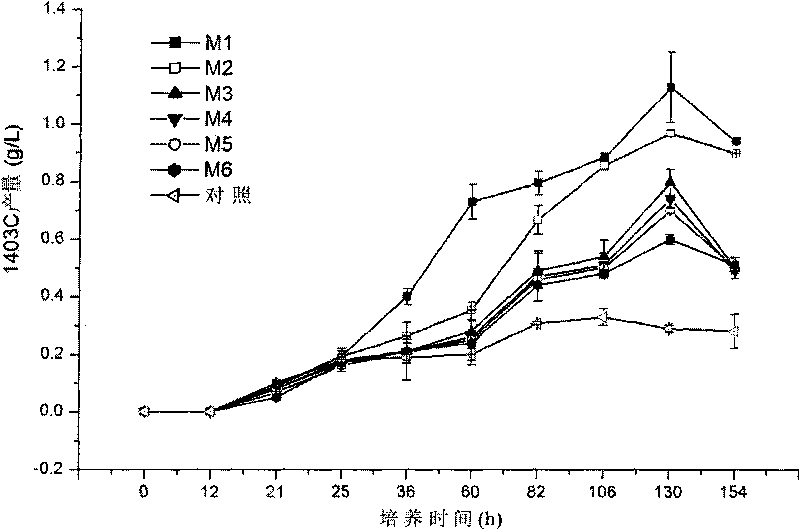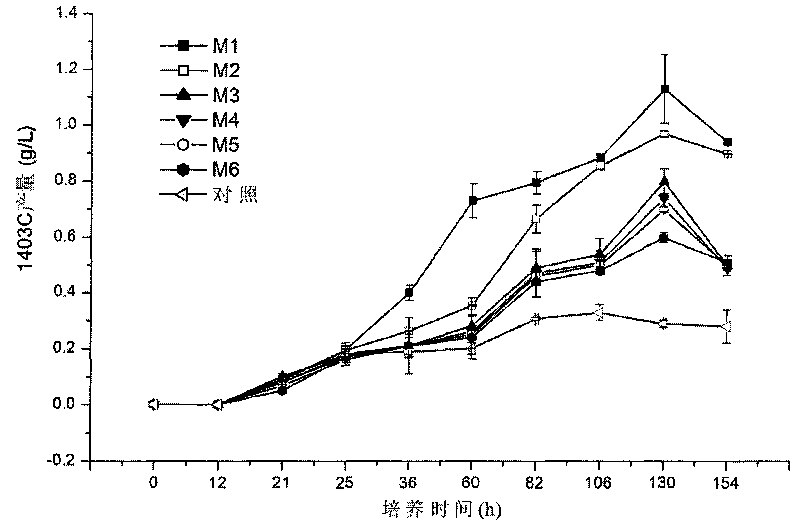Method for improving output of anticancer anthraquinone compound generated by Fusarium proliferatum via utilizing different vaccination ways
A technology of endophytic fungi and mangroves, applied in the field of quinone anticancer compound 1403C production, can solve the problem of low 1403C production and achieve the effect of increasing production
- Summary
- Abstract
- Description
- Claims
- Application Information
AI Technical Summary
Problems solved by technology
Method used
Image
Examples
Embodiment 1
[0045] Example 1 The yield of 1403C obtained by fermentation using inoculation method M1
[0046] Adopt a 500mL Erlenmeyer flask with three baffles (the center of the baffle is 18.5cm away from the mouth of the bottle, 0.5cm away from the bottom of the bottle, and the width of the axial leaf end of the baffle is 0.9cm. The shape of the baffle is trapezoidal, and the baffle is integrated with the main body of the bottle Blown), filled with 100mL seed culture medium, sterilized at 121°C for 20 minutes, picked well-grown seeds from the slant culture medium and put them into the above-mentioned bottle. When the seeds are well grown, grind them aseptically. Inoculated into the fermentation medium with an inoculum of 5%. Such as figure 1 As shown in (M1), the yield of 1403C increased rapidly after 25h, and reached the maximum after 130h of fermentation, which was 1.13g / L, which was 289.7% higher than that of the control group (0.29g / L).
Embodiment 2
[0047] Example 2 The yield of 1403C obtained by fermentation using the inoculation method M2
[0048] Adopt a 500mL Erlenmeyer flask with three baffles (the center of the baffle is 18.5cm away from the mouth of the bottle, 0.5cm away from the bottom of the bottle, and the width of the axial leaf end of the baffle is 0.9cm. The shape of the baffle is trapezoidal, and the conical The baffle in the bottle is integrally blown with the main body of the bottle), filled with 100mL seed medium, sterilized at 121°C for 20min, and picked well-grown seeds from the slant medium and put them into the above-mentioned bottle. After the seeds grow well, they are inserted into the fermentation medium with an inoculation amount of 5%. Such as figure 1 As shown in (M2), the yield of 1403C increased rapidly after 36h, and reached the maximum after 130h of fermentation, which was 0.97g / L, which was 234.5% higher than that of the control group (0.29g / L).
Embodiment 3
[0049] Example 3 The yield of 1403C obtained by fermentation using the inoculation method M3
[0050] Use a 500mL Erlenmeyer flask without baffles, add ten glass beads (diameter 3mm), fill in 100mL seed medium, sterilize at 121°C for 20min, pick well-grown seeds from the slant medium and put them into the above bottle middle. After the seeds grow well, they are inserted into the fermentation medium with an inoculation amount of 5%. Such as figure 1 As shown in (M3), the yield of 1403C increased rapidly after 36h, and reached the maximum after 130h of fermentation, which was 0.8g / L, which was 175.9% higher than that of the control group (0.29g / L).
PUM
 Login to View More
Login to View More Abstract
Description
Claims
Application Information
 Login to View More
Login to View More - R&D
- Intellectual Property
- Life Sciences
- Materials
- Tech Scout
- Unparalleled Data Quality
- Higher Quality Content
- 60% Fewer Hallucinations
Browse by: Latest US Patents, China's latest patents, Technical Efficacy Thesaurus, Application Domain, Technology Topic, Popular Technical Reports.
© 2025 PatSnap. All rights reserved.Legal|Privacy policy|Modern Slavery Act Transparency Statement|Sitemap|About US| Contact US: help@patsnap.com


